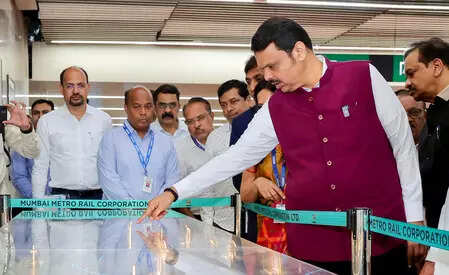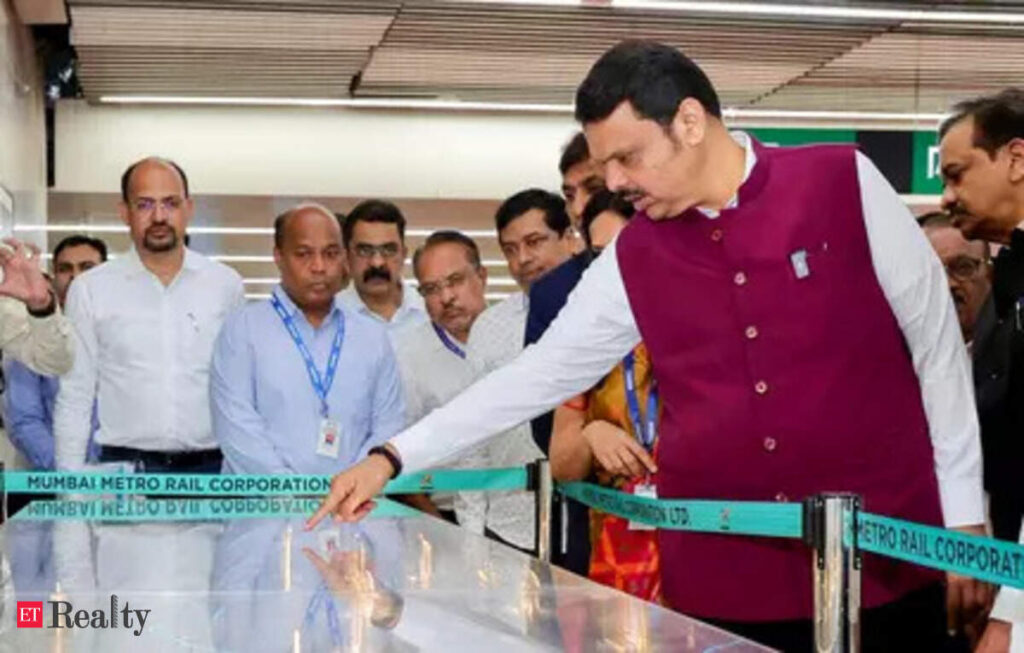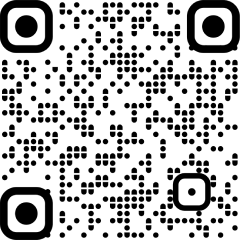
MUMBAI: The final phase of Mumbai Metro Line 3 between Acharya Atre Chowk in Worli and Cuffe Parade in south Mumbai will become operational in August, Maharashtra Chief Minister Devendra Fadnavis announced on Friday.
Services from Bandra-Kurla Complex (BKC) to Acharya Atre Chowk are set to start from Saturday, he said. Fadnavis and deputy Chief Minister Eknath Shinde rode by a Metro train through the underground corridor from BKC to Siddhivinayak Temple on Friday afternoon.
Speaking to reporters after the 10-minute ride, Fadnavis said the BKC to Acharya Atre Chowk section (phase 2A) of Metro Line 3 will be open to the public from Saturday morning. Last year, the 13 km stretch between JVLR Aarey and BKC was thrown open for the public, he noted.
Phase 2A of Metro Line 3, also called Aqua Line, is 9.77 km long, and its tunnel has been built through the ‘rockbed’ underneath the Mithi River, officials said. It will have six stations, namely, Dharavi, Shitaladevi, Dadar West, Siddhivinayak, Worli, and Acharya Atre Chowk.
Fadnavis said Prime Minister Narendra Modi will be invited when the final phase between Atre Chowk and Cuff Parade will become operational. The Colaba-BKC-Aarey line is the longest underground Metro route in the country, and the project is an “engineering marvel” as the corridor passes beneath the Mithi river and densely-populated areas like Girgaon, the chief minister noted. The work of two stations in the next phase is in final stages, and once it is completed, the entire metro corridor will be opened to the public, he said.
“The Metro stretch that is operational is receiving good response. Ridership is increasing, and when end-to-end connectivity becomes available, the ridership will increase more,” said the chief minister. The underground metro corridor has 26 stations and boasts of a state-of-the-art design with multiple entry and exit points which will avoid congestion, he said.
Metro-3 will provide excellent connectivity for the airport, Fadnavis said, adding it will take some time due to ongoing constructions, but until then shuttle services will be operated for the convenience of passengers. Trials of the common mobility card for all modes of transport in Mumbai including Metro, monorail, railways and BEST buses have been successful so far, and once all the trials are over, the card will be rolled out commercially, he said.
“Mumbaikars will then get an end-to-end solution,” Fadnavis added. The authorities have entered into a tie-up with Google to enable passengers to track the location of BEST buses in real time, and train passengers too would be able to use this facility, he said.
Deputy CM Shinde said that due to Metro 3, nearly five lakh vehicles will go off the roads, which will save a large amount of fuel and time. “When this 33 km stretch is completed, you will be able to travel from end to end within an hour,” Shinde said.
With the extension to Acharya Atre Chowk becoming operational, Metro 3 will provide connectivity between BKC and the business hubs in Worli, Lower Parel and Prabhadevi. Reaching the shrines of Siddhivinayak temple, Shitaladevi temple and Mahim Darga too will become more convenient.
As per the Mumbai Metro Rail Corporation, the minimum fare will be Rs 10 and the maximum fare will be Rs 40 for the journey in phase 2A of the underground corridor. For the travel between JVRL Aarey and Acharya Atre Chowk, passengers will have to shell out Rs 60.
MMRC has planned 244 services on the corridor with eight Metro trains, and the travel time between BKC and Acharya Atre Chowk will be 15-20 minutes, while that between JVRL Aarey and Acharya Atre Chowk will be 36 minutes. The headway between two trains will be 6 minutes and 20 seconds.



